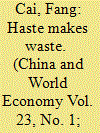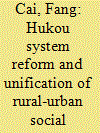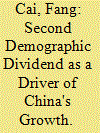|
|
|
Sort Order |
|
|
|
Items / Page
|
|
|
|
|
|
|
| Srl | Item |
| 1 |
ID:
074182


|
|
|
|
|
| Publication |
2006.
|
| Summary/Abstract |
Demographic transition has occurred more rapidly in China than in most developed countries. As the population ages, the growth rate of the working age population has started to decline and the absolute quantity of the working age population will begin to shrink after 2015, which will inevitably result in structural labor shortage. Under the circumstance where comparative advantage is still embodied in its labor-intensive commodities, timely and sufficient supply of a skilled labor force is vital for China to sustain fast economic growth.
|
|
|
|
|
|
|
|
|
|
|
|
|
|
|
|
| 2 |
ID:
096222


|
|
|
|
|
| Publication |
2010.
|
| Summary/Abstract |
Using an input-output method, this paper simulates the impacts of the global financial crisis and the decline of exports on China's economy and employment. With shrinking external demand, boosting domestic demand becomes crucial for maintaining economic growth and promoting employment. Our simulated results indicate that an investment scenario with employment as a priority can achieve the objective of employment maximization without significantly reducing growth. Public investment should focus on employment, education, health, housing and social security to rebalance China's economy so that it can realize sustained and stable economic growth.
|
|
|
|
|
|
|
|
|
|
|
|
|
|
|
|
| 3 |
ID:
137595


|
|
|
|
|
| Summary/Abstract |
This paper provides a framework for assessing the health of China's macro economy and the sustainability of economic growth by combining supply-side and demand-side factors and by considering their relationship at different stages of development. As the Chinese economy passed through its Lewis turning point, weakened supply-side factors caused its growth to slow. The increasing concern regarding the economic slowdown has induced both the central and local governments to implement various stimulus plans through instruments of macroeconomic, industrial and regional policies. By examining where the imbalances of the Chinese economy really lie and investigating the determinants of the current slowdown and of the enhancement of the potential growth rate, the present paper suggests that the best path of action for the Chinese Government is not to stimulate growth through demand-side factors but to increase the potential growth rate through reforms in certain key areas.
|
|
|
|
|
|
|
|
|
|
|
|
|
|
|
|
| 4 |
ID:
105072


|
|
|
|
|
| Publication |
2011.
|
| Summary/Abstract |
Using a political economy analytical framework, the present paper examines the hukou system reform in China. The potential unification of the social welfare system of rural and urban areas is discussed. The paper reviews the progress of hukou system reform since 2004. It is suggested that since China met its Lewis turning point in about 2004, and a labor shortage became a limiting factor in production, there has been stronger demand for hukou system reform. In the meantime, various levels of government have a point where incentives are compatibile for carrying out reforms. The paper also explores some limitations of the currently implemented reform in certain regions and puts forward relevant policy suggestions.
|
|
|
|
|
|
|
|
|
|
|
|
|
|
|
|
| 5 |
ID:
111483


|
|
|
|
|
| Publication |
2012.
|
| Summary/Abstract |
Through review of relevant studies and analysis, this article indicates that the "middle-income trap" is in line with the framework of the mainstream economic growth theories, and, therefore, it is a useful concept through which we can analyze economic growth phenomena in specific economic growth phases. The empirical experiences of many countries also indicate that at specific middle-income stages, economies with high rates of growth tend to encounter economic slowdown or even stagnation. The article shows that China is facing the challenge of determining how to move smoothly beyond the middle-income stage of economic development, while taking into account the shifting population structure, changing resource endowment and growth patterns. The article, drawing on international experiences, puts forward several policy suggestions relating to improvement in total factor productivity, expansion of human capital accumulation and deepening of system and government function reforms.
|
|
|
|
|
|
|
|
|
|
|
|
|
|
|
|
| 6 |
ID:
158906


|
|
|
|
|
| Summary/Abstract |
China's reform, opening up and resultant economic growth in the past 40 years have led to the accumulation of an immense array of experiences, which economists are obligated to look into, analyze and theorize upon. In fact, the rich literature in this area has positively assessed and documented China's successful experiences. However, theories that were established in Western countries have been applied as doctrine to judge China's experiences. By adopting an analytical framework unifying historical logic and theoretical logic, the purpose of this paper is to reveal the unique Chinese experience and its relevance to the general laws of economic development. Based on the experiences of and in reference to research findings about China, this paper chronicles the process of reform, opening up and economic growth, and analyzes the nexus between them. The study demystifies how the incentive mechanism, the factor accumulation and allocation system, market development, and macro policy environment reforms have spurred China's economic growth, structural changes and the increase in productivity. The changes in development stage are examined and policy implications for further reform are discussed.
|
|
|
|
|
|
|
|
|
|
|
|
|
|
|
|
| 7 |
ID:
119155


|
|
|
|
|
| Publication |
2013.
|
| Summary/Abstract |
As a result of the shrinking working age population (aged 15 to 59 years), all factors that have driven China's rapid economic growth over the past 30 years tend to diminish from 2010. The present paper estimates the average annual growth rate of potential output to be 7.2 percent over the 12th Five-year Plan period and 6.1 percent over the 13th Five-year Plan period. Future sustainable growth requires furthering economic reform in related areas to enhance potential growth. This paper simulates two scenarios in which both an increase in labor force participation and improvement in total factor productivity can significantly enhance the potential GDP growth rate. Relevant policy implications are discussed.
|
|
|
|
|
|
|
|
|
|
|
|
|
|
|
|
| 8 |
ID:
190394


|
|
|
|
|
| Summary/Abstract |
The structural changes that the Chinese economy has been experiencing since its working-age population began to decline pose challenges for its further growth. First, as it loses its comparative advantage in labor-intensive activities, the share of manufacturing in its GDP has shrunk. Second, unproductive enterprises that are reluctant to exit the market tend to seek policy protection, which leads to the immobility of resource allocation. Third, the reallocation of the labor force from the highly productive manufacturing sector to the low-productivity service sector leads to the degradation of resource allocation. The inadequate exploitation of the potential of resource reallocation implies that the decline in manufacturing is premature. It is therefore important to combine market competition policy, industrial policy, and social protection policy to stabilize the development of manufacturing.
|
|
|
|
|
|
|
|
|
|
|
|
|
|
|
|
| 9 |
ID:
175572


|
|
|
|
|
| Summary/Abstract |
As China's demographic transition enters a new stage, the “first demographic dividend” – the economic advantage resulting from demographic changes in recent decades – is bound to disappear permanently. China's future development will be characterized by an aging population. The “second demographic dividend” refers to new sources of economic growth derived from this later population change. This paper reveals major constraints caused by aging in China, which is characterized by a tendency to grow old before becoming rich. As the population ages, human capital improvement slows, labor force participation declines and consumption power reduces. This paper suggests taking advantage of a population “echo effect” to improve human capital at all ages, to enhance workers’ ability to benefit from employment, and to improve the labor participation rate of the elderly, which in turn would increase the income and social security of the aged. These measures are conducive to future economic growth and to the cultivation of the second demographic dividend.
|
|
|
|
|
|
|
|
|
|
|
|
|
|
|
|
| 10 |
ID:
110505


|
|
|
|
|
| Publication |
2011.
|
| Summary/Abstract |
We examine the wage trends of ordinary workers and the wage convergence between unskilled and skilled workers in China. First, we find that wages in all non-agricultural sectors, wages of migrant workers, and wages of hired workers in the agricultural sector have increased dramatically since 2003. Second, through comparing wage differentials between migrant and urban resident workers and between heterogeneous education groups within migrant workers, and by investigating the changes in the contribution of the returns to education to wage differentials, we find that the wages of unskilled and skilled workers have converged. Both the increasing wage trends and wage convergence are interpreted as evidence supporting the hypothesis that China has passed what can be called the Lewis turning point in the industrial sector. We conclude that the sustainability of economic growth in China requires an upgrading of labor market institutions to accommodate the merging of the rural and urban labor forces.
|
|
|
|
|
|
|
|
|
|
|
|
|
|
|
|
|
|
|
|
|